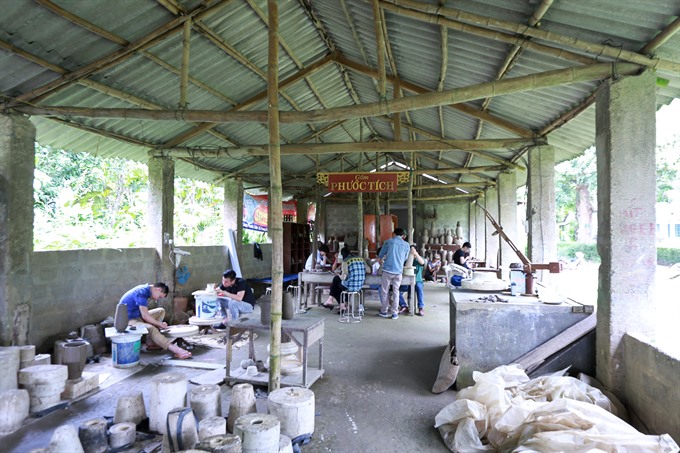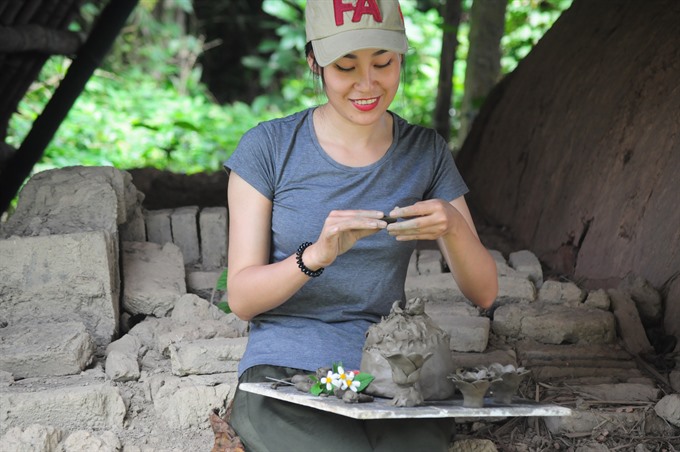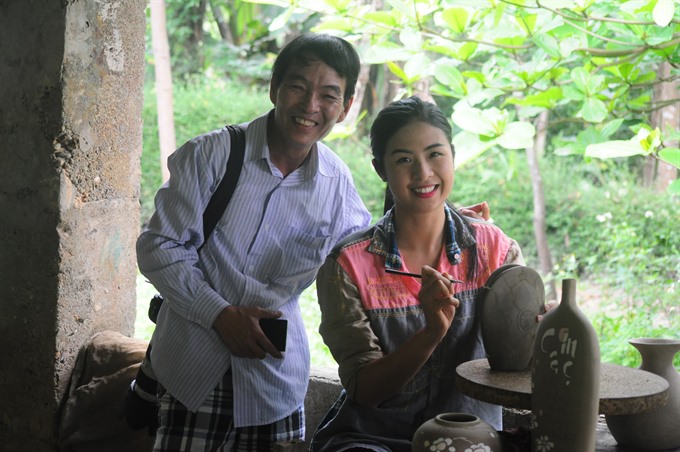 Features
Features

The future looked bleak for Phước Tích Village’s pottery industry. Thanks to a group of fashion designers, there may be new hope for the ancient craft.
 |
| Out of the city: Phước Tích pottery workshop bustles with the presence of well-known fashion designer and celebrities. VNS Photo Nguyễn Văn Sum |
The future looked bleak for Phước Tích Village’s pottery industry. Thanks to a group of fashion designers, there may be new hope for the ancient craft, Huê Phong reports.
In mid-March, Minh Hạnh, one of the country’s most prominent contemporary fashion designers, led a group of young, gifted designers to Phước Tích, a 546-year-old village on the outskirts of Huế, for a two-day clay workshop.
“The pottery of this particular village is unique and they produce good quality products. The key is to make attractive designs that can be sold at the market,” said Minh Hạnh, adding that the fashion designers would use pottery to convey their design ideas.
The presence of the showy designers was incongruous against the backdrop of the ancient village, 40 kilometres from the former royal capital city. The sight of the designers, including some celebrities, getting dirty with the sticky clay attracted a lot of attention from the public.
Over the course of two days at the village’s pottery workshop, the designers were instructed to give facelifts to the pre-made pottery designs. Over almost 16 hours of work on March 16 and 17, the designers sought inspiration to fulfill their assignment before being able to start on their own work.
 |
| Hard at work: Designer Hiền Đặng works on her kapok flowers creation. VNS Photo Phước Bửu |
More familiar with air-conditioning and clean, modern tools, the designers slummed it with their bare hands and dirty clay. Surprisingly, there was a lot of enthusiasm. Even the female designers seemed to have no qualms with getting stuck in and possibly ruining their manicures.
“Of course, [working with clay] is something unfamiliar to me but I could get used to it. Obviously we came here with a love of art, so the unfamiliarity is no hindrance to our creativity,” said Hiền Đặng, a designer from Hà Nội.
Hiền completed her assignments on the first day by putting additional patterns on unbaked vases, and thus on the second day had the chance to put her creations on terracotta trays embossed with lotus flowers, roses and red kapok flowers.
She explained that those were her favourite flowers and the trays would reflect her love of Phước Tích pottery.
Different designers came up with different methods to turn the rusty pottery items into art works, including cut-outs, embossed patterns or reshaping the items to give them a more artistic value.
According to Lương Thanh Hiền, manager of the pottery workshop, the usual designs have remained unchanged for years, and so have seen a drop in popularity.
“We have collaborated with the designers not only to improve the quality of our products, but also to increase public awareness of our village and its pottery heritage,” Hạnh said.
 |
| Starstruck: Photographer Sum poses with Miss Việt Nam 2010, Ngọc Hân, and her work-in-progress. VNS Photo Phước Bửu |
Ngọc Hân, for example, live-streamed her work on Facebook, attracting over 10,000 views.
Hân was Miss Việt Nam 2010 and has a great number of followers on Facebook. She is also working as a fashion designer and was part of the group that visited the pottery village.
Hạnh explained that the ultimate aim of the working visit was to find a better market for Phước Tích pottery. “[The members of the group] have shops in Hội An and Huế and could help selling these items,” Hạnh said. “We hope we can get some good sales thanks to our connections.”
Products redesigned or crafted by the designers would be displayed at an upcoming festival in Huế for craft villages around the country.
Hiền, manager of the workshop, said the unbaked pottery would need weeks to be baked and packaged before it’s ready for presenting at the festival.
He said the items could be sold as works of art.
“No matter what they are, we hope that the designs by the designers will help attract customers to our village and its pottery,” he said.
The village began to craft potteries in 1470, and enjoyed a period of success during the Nguyễn Dynasty (1802-1945), when the village was the only supplier for the royal family’s pottery.
Products included jars, pots and containers used for cooking and storage. Some of the most outstanding works by Phước Tích artisans are preserved at the Huế Museum of Royal Antiquities.
At that time, the village’s potteries were also available for home use in the central provinces of Quảng Bình, Quảng Trị, Quảng Nam and Quảng Ngãi.
However, kilns at the village stopped burning in 1967 due to the war and it took the village 12 years to restart the craft. The villagers had to travel long distances to Hà Nội and Bình Dương to learn craft skills from Hương Canh and Lái Thiêu artisans, so they could resume production.
All 12 earthen kilns at the village, used for centuries, had been ruined, and the villagers had to adopt a gas-operated kiln. Unfortunately the products remained unsold, despite the villagers’ best efforts.
Later in 2010, a project funded by Luxembourg helped to rebuild a wood burning kiln that is a replica of the ancient kilns used by the village. This delighted local potters and they hoped to regain the glory days of their ancestors.
Once again Phước Tích potters came to study at the pottery facilities of northern and southern localities, including Bát Tràng in Hà Nội.
The working visit by the fashion designers once again nurtures hope for the villagers, who are still seeking a way to save the craft of their ancestors. VNS
 |
| Clay creations: The completed products are dried under the sun. VNS Photo Phước Bửu |
 |
| Concentration: A designer working on his product. VNS Photo Phước Bửu |




